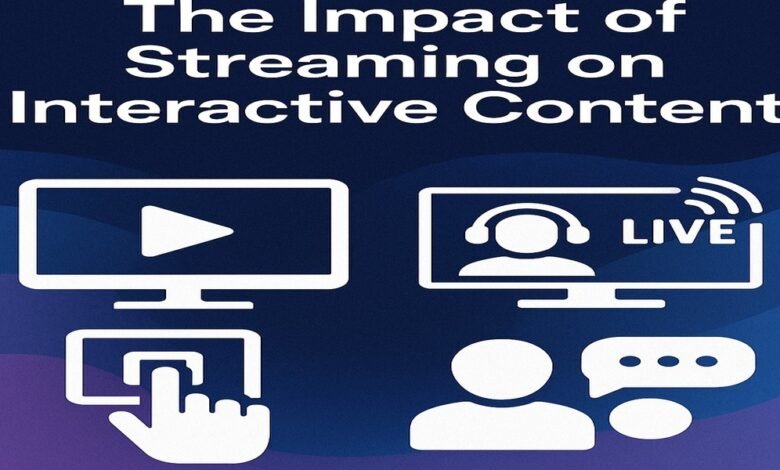The Impact of Streaming on Interactive Content

In the ever-evolving digital era, the way we consume entertainment has drastically transformed. Gone are the days when traditional TV and linear storytelling dominated our screens. Today, streaming platforms like Netflix, YouTube, and Twitch are leading a revolution not just in passive viewing—but in interactive content. This shift is redefining user engagement, storytelling formats, and even how creators design content to meet the evolving expectations of a global audience.
Findings shared in TheYucatanTimes’s report highlight a growing trend: interactive content is no longer just an experimental form—it’s becoming mainstream. Audiences now crave personalized experiences, and streaming platforms are answering that call. From “choose your own adventure” formats to real-time viewer-driven live streams, the fusion of streaming and interactivity is creating new dimensions of engagement. These innovations are not only entertaining but are also shaping the way content is produced, distributed, and monetized.
Why Interactive Content Thrives on Streaming Platforms
Streaming services provide an on-demand ecosystem, which is ideal for interactive media. With the ability to control pacing, structure, and even outcomes, viewers are becoming active participants rather than passive observers. Platforms like Netflix pioneered this concept with shows like Bandersnatch, while YouTube allows creators to add clickable storylines that influence video progression.
Moreover, live-streaming platforms such as Twitch take interaction to another level. Here, viewers can comment, donate, vote, and influence gameplay or content direction in real time. These dynamic feedback loops not only create highly engaging experiences but also foster loyal communities and viewer retention.
The Role of Data in Shaping Interactive Experiences
One of the strongest assets streaming platforms possess is data. Unlike traditional TV, streaming platforms collect vast amounts of user behavior data—what people watch, when they pause, skip, or stop watching. This insight helps tailor content experiences and fine-tune interactive narratives. In fact, many interactive shows now adjust story arcs or create spin-offs based on user engagement metrics, allowing creators to serve exactly what the audience wants.
Additionally, AI and machine learning are increasingly being integrated to personalize content on a one-to-one basis. Whether it’s suggesting alternate endings or guiding viewers through decision paths based on their history, the streaming-interactive duo is setting a new benchmark for custom experiences.
Monetization Opportunities for Creators and Platforms
With interactivity, new monetization models are emerging. Instead of relying solely on subscriptions or ads, platforms and creators are exploring options such as in-stream purchases, pay-to-unlock features, and real-time donations. Gamified content is also gaining traction, blending entertainment with challenge-based formats that reward users with digital goods, NFTs, or exclusive content.
Streaming services are also forming partnerships with brands to create branded interactive experiences, effectively turning viewers into engaged consumers. This blend of entertainment and commerce is redefining advertising and expanding the creator economy.
Educational and Social Applications
Beyond entertainment, interactive content on streaming platforms is proving valuable in education, training, and social impact. Interactive tutorials, language learning tools, and even virtual field trips are becoming more common. These applications leverage the same technology but serve informative and practical purposes, making learning more engaging and participatory.
Moreover, nonprofits and awareness campaigns are adopting interactive storytelling to evoke stronger emotional responses and drive action. By putting viewers in the driver’s seat, these experiences create empathy and better understanding around complex social issues.
The Future: A Hybrid Entertainment Landscape
The integration of streaming and interactive content is just the beginning. As virtual reality (VR), augmented reality (AR), and spatial computing become more accessible, the next frontier is immersive, multi-sensory storytelling. Soon, users won’t just click to choose—they’ll walk through digital stories, touch virtual objects, and converse with AI-driven characters.
Streaming platforms are evolving into interactive ecosystems where stories are shaped not just by writers and directors, but by the audience itself. In this hybrid landscape, the line between creator and consumer blurs—giving rise to a new form of co-authored media.
Conclusion
The impact of streaming on interactive content is monumental and still unfolding. What began as a niche experiment is now a central pillar of how stories are told and experienced in the digital age. With powerful data insights, advanced technology, and a hungry audience, the future of interactive content looks not only promising but inevitable. Platforms, creators, and consumers are all in this together—co-creating the next chapter of entertainment history.





